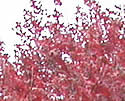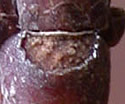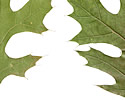Quercus rubra (Northern Red Oak)
| Also known as: | |
|---|---|
| Genus: | Quercus |
| Family: | Fagaceae (Beech) |
| Life cycle: | perennial woody |
| Origin: | native |
| Habitat: | part shade, sun; heavier, well drained soil; forest |
| Bloom season: | mid May |
| Plant height: | 60 to 80 feet |
| Wetland Indicator Status: | GP: FACU MW: FACU NCNE: FACU |
| MN county distribution (click map to enlarge): |  |
| National distribution (click map to enlarge): |  |
Pick an image for a larger view. See the glossary for icon descriptions.
Detailed Information
Flower: 
![[photo of flowers]](/udata/r9ndp23q/pd3/quercus-rubra-7098-2-t.jpg) Male and female flowers are borne separately on the same branch, the males on 1½ to 3 inch long green, string-like clusters (called catkins) from bud clusters at the tip of the previous season's growth. 1 to 3 female flowers, with bright red styles and a short, stubby, green stalk, sit in the leaf axils of new growth.
Male and female flowers are borne separately on the same branch, the males on 1½ to 3 inch long green, string-like clusters (called catkins) from bud clusters at the tip of the previous season's growth. 1 to 3 female flowers, with bright red styles and a short, stubby, green stalk, sit in the leaf axils of new growth.
Leaves and bark: 

![[photo of leaves]](/udata/r9ndp23q/trees/quercus-rubra-9-t.jpg) Leaves are simple and alternate, oval to elliptic in outline, broadest just above the middle, 4 to 8 inches long and 4 to 5½ inches wide, each side with 2 to 4 dominant lobes, each with 2 to 3 or more, sharp, bristle tipped points. The sinuses between the major lobes are typically narrowly angled at the deepest point, though may be rounded, and typically extend less than ¾ the distance to the midrib. Upper surface is deep green with a dull sheen, the lower light green and dull with patches of fine hair where the leave veins diverge. Red oaks can obtain brilliant red fall color before fading to a dull reddish brown and often persist on the tree until pushed off by spring bud breakage.
Leaves are simple and alternate, oval to elliptic in outline, broadest just above the middle, 4 to 8 inches long and 4 to 5½ inches wide, each side with 2 to 4 dominant lobes, each with 2 to 3 or more, sharp, bristle tipped points. The sinuses between the major lobes are typically narrowly angled at the deepest point, though may be rounded, and typically extend less than ¾ the distance to the midrib. Upper surface is deep green with a dull sheen, the lower light green and dull with patches of fine hair where the leave veins diverge. Red oaks can obtain brilliant red fall color before fading to a dull reddish brown and often persist on the tree until pushed off by spring bud breakage.
![[photo of trunk]](/udata/r9ndp23q/pd3/quercus-rubra-8958309-1-t.jpg) The trunk can be over 40" in diameter at breast height (dbh). In closed canopy forests it is tall and straight with few or no lower branches but in more open areas, lower branches create a large round crown quite close to the ground. The bark is gray, medium to coarse textured, very hard, with flattened, plate like ridges but is nearly smooth on the branches. Twigs are reddish brown, often glossy.
The trunk can be over 40" in diameter at breast height (dbh). In closed canopy forests it is tall and straight with few or no lower branches but in more open areas, lower branches create a large round crown quite close to the ground. The bark is gray, medium to coarse textured, very hard, with flattened, plate like ridges but is nearly smooth on the branches. Twigs are reddish brown, often glossy.
Fruit: 
![[photo of fruit]](/udata/r9ndp23q/pd3/quercus-rubra-27987-t.jpg) Fruit is a round to egg shaped to oblong nut (acorn) ½ to just under 1 inch long, with a flat plate-like scaly cap with that barely encloses the base of the acorn, on a short stalk.
Fruit is a round to egg shaped to oblong nut (acorn) ½ to just under 1 inch long, with a flat plate-like scaly cap with that barely encloses the base of the acorn, on a short stalk.
Notes:
Northern Red Oak is a "Big Woods" forest species, and while its saplings are quite shade intolerant it typically occurs in mixed stands of elm, linden, ash and maple though intolerance to flooding keeps it out of swampy areas and floodplains. Though not as fire tolerant It can also be found in drier, sandy sites often growing side by side with its closest look alike, Northern Pin Oak, (Quercus ellipsoidalis). Few other trees have caused so much struggle for amateur botanists than these two, and adding to this they can hybridize. Over all the leaves of Red Oak are larger with more lobes and shallower, narrower sinuses (usually angled), and the primary lobes are proportionately broader than Pin Oak. The acorns of Red Oak are much larger and more oblong shaped with the cap barely enclosing the end of the nut.
Native Plant Nurseries, Restoration and Landscaping Services ↓
More photos
 Northern Red Oak in a home landscape
Northern Red Oak in a home landscape fall color
fall color Northern Red Oak buds and bud scars
Northern Red Oak buds and bud scars more leaves
more leaves compare Red Oak and Pin Oak leaves
compare Red Oak and Pin Oak leaves
Photos by K. Chayka taken in Ramsey County. Photos courtesy Peter M. Dziuk taken in Anoka and Ramsey counties.
Comments
Have you seen this plant in Minnesota, or have any other comments about it?
on: 2022-07-29 16:05:58
On Superior Hiking Trail between Finland and Little Marais. Occasional in sugar maple and paper birch forest.
on: 2022-08-12 19:50:55
There's plenty Northern Red Oaks in Theodore Wirth Park in Minneapolis.






